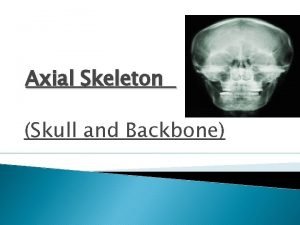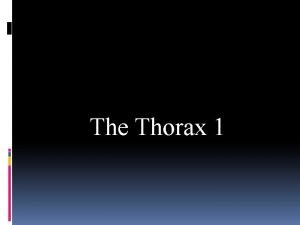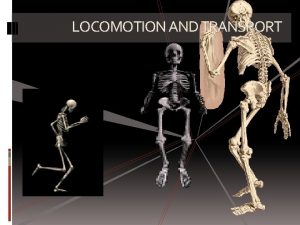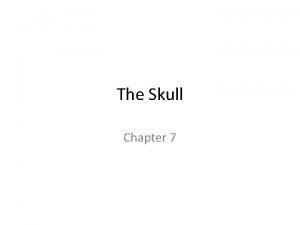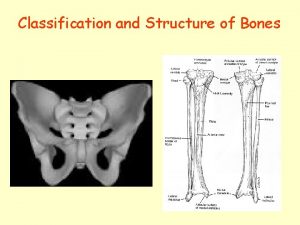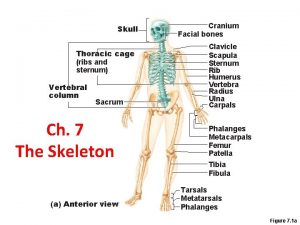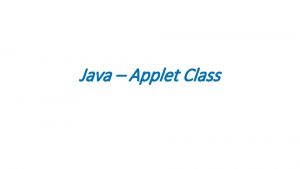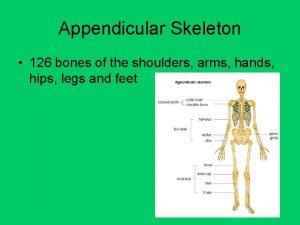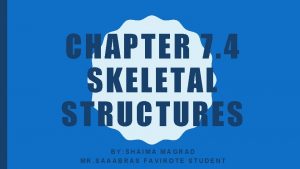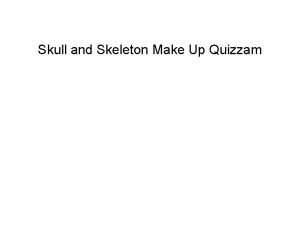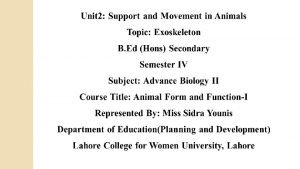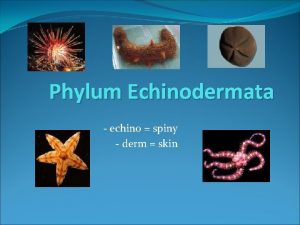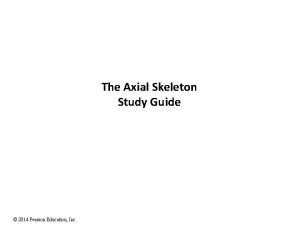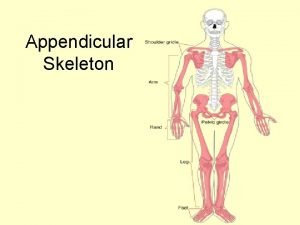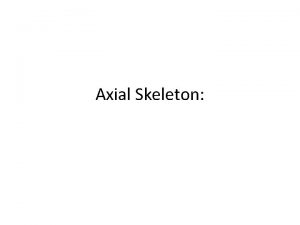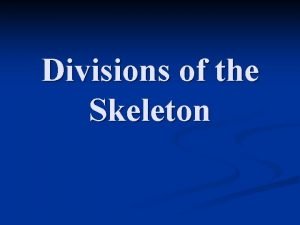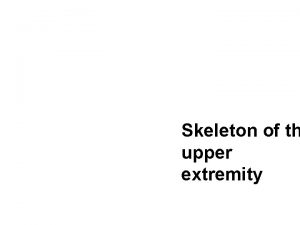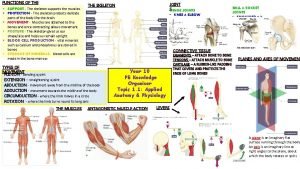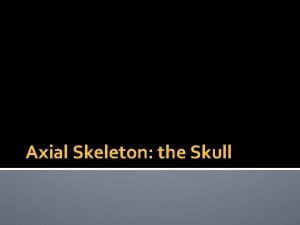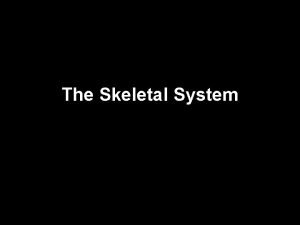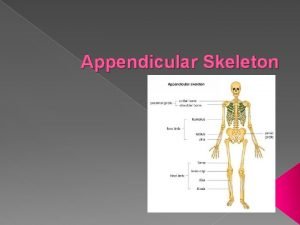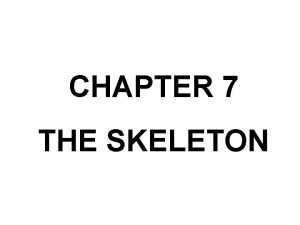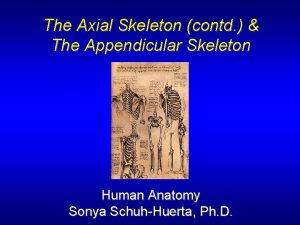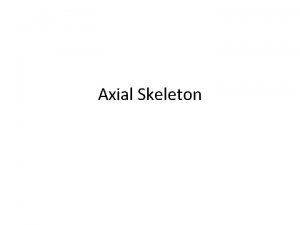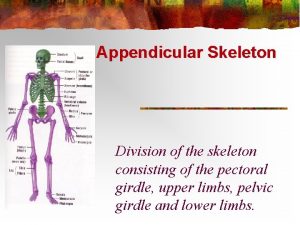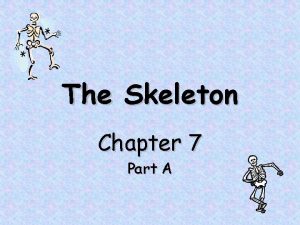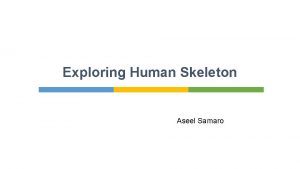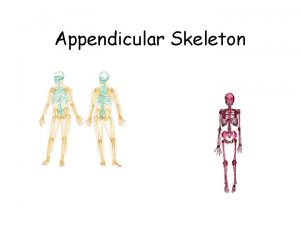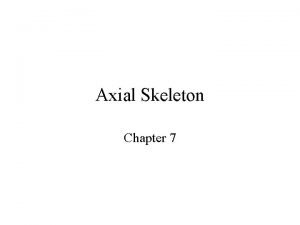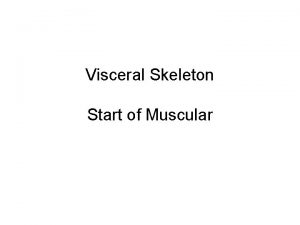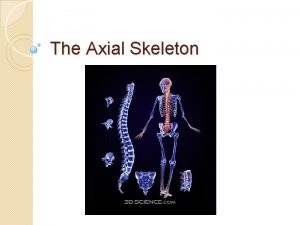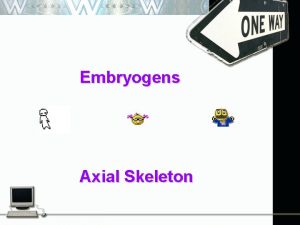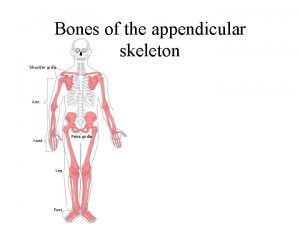The Skeleton n n n What the skeleton


























































- Slides: 58

The Skeleton n n n What the skeleton does? The skeleton is the basic framework of the body. It has four major functions SHAPE AND SUPPORT MOVEMENT PROTECTION BLOOD PRODUCTION SHAPE AND SUPPORT - the skeleton provides us with our shape, without it our body would have no framework to support itself on. The skeleton also

gives the body its size and in some cases can influence overall bodyweight. MOVEMENT - some of the bones of the body are held together by freely moveable joints. This means you are able to bend your body and move about. n n PROTECTION - The skeleton also protects the vital soft tissue organs of the body. The most important are: the rib cage - protects the heart and the lungs the pelvic girdle - protects the abdomen the spinal column chord - protects the spinal chord the skull - protects the brain.

n BLOOD PROTECTION - blood is made in the bone marrow, particularly in the marrow of the long bones of the body. Blood contains both red and white blood cells. The red blood cells carry oxygen to muscles and the white blood cells fight infection in the body.

Types of Bones n There are over 200 bones in the body and over 100 joints. n Bones are divided into three main types : n FLAT BONES - the scapula, the patella, the sternum, the pelvis and the ribs IRREGULAR BONES - the vertebrae and the short bones of the hands and feet. LONG BONES - the bones of the arms and the legs, and the long bones in the hands and feet. n n

n n n CRANIUM - the brain case made up of EIGHT flat bones CLAVICLE AND SCAPULA - collar and shoulder bones that make up the shoulder. SCAPULA also connects the arm to the central skeleton. STERNUM - has 10 pairs of ribs attached to it. RIBS HUMERUS RADUIS AND ULNA - rotate around each other, letting you turn your palms up and down.

n n n n PELVIS - where the legs are connected to the skeleton PHALANGES - make up fingers and toes FEMUR - longest bone in the body. Stronger weight for weight than steel. PATELLA - kneecap, protects the knee joint. It is embedded in the tendon of a muscle and not attached to any other bone. FIBULA TIBIA - shin bone. Male skeletons tend to be bigger and female skeletons have a wider pelvis so that is easier to have children.

Task: 1. Name all the bones numbered 1 -18 í í í 2. State whether the bone is a: long bone irregular bone flat bone

Joints and Movement n n There are many types of joint in the body, including joints that we do not move and joints that only move slightly. The movement of joints are important factors affecting participation and performance. JOINT STRUCTURE most joints are synovial joints. Synovial joints are enclosed inside a capsule filled with a lubricating fluid, called synovial fluid. This fluid reduces the friction on the joint surfaces as they move against each other. A membrane seals the synovial capsule so that the fluid does not leak out.

n n n CARTILAGE joint surfaces are also covered by smooth, slippery hyaline cartilage. This aids the production of synovial fluid. Joints often include another kind of cartilage, called white fibro-cartilage. This is is smooth and hard in order to help free movement, fibro-cartilage is tough and elastic. It acts as a shock absorber cushioning impact on the synovial joints. For example the knee contains fibro-cartilage to cushion the joint against the impact of walking, running and jumping. LIGAMENTS AND TENDONS ligaments and tendon hold together moving joints. Ligaments are very strong elastic fibres that keep joints intact.

n n n all the major joints rely on ligaments and tendons for stability. tendons attach muscles to bones. both ligaments and tendons can be strained or torn as a result of violent movement. TYPES OF MOVEMENT – since movement is so important in sport and physical activity, there are terms to describe the different kinds of movement. » » FLEXION EXTENSION ROTATION ABDUCTION » ADDUCTION

n DIFFERENT TYPES OF MOVEMENT: n FLEXION - flexion is the bending of a joint. For example, flexion occurs at the knee as the foot is drawn back to kick a ball. n EXTENSION - extension is the straightening of a limb at the joint. For example, when putting the shot the elbow is straightened during release. n ROTATION - rotation is the ‘swivelling’ of a joint. for example, moving the head from side to side.

n n ABDUCTION AND ADDUCTION abduction involves moving a limb (s) away from the central axis of your body. adduction is the opposite from abduction, moving a limb (s) back towards the central axis of your body. the central axis is a straight line travelling from the top of your head straight down to the ground.

Types of Joints n The type of joints that are particularly important for physical activity and sport are: – BALL AND SOCKET JOINT - allows a full range of movement. E. g. the hip and shoulder joints – HINGE JOINT - movement in one plane: flexion and extension.

– GLIDING JOINT - these occur in the many small bones of the hand feet. They allow a slight sliding motion forwards and backwards and from side to side. – PIVOT JOINT - allows rotation. E. g. atlas and axis in the neck.

n n n TASK: the picture shows: 1: Shoulder joint -ball and socket 2: Elbow joint - hinge joint can you name another ball and socket and hinge joint?

Muscles n Every movement of your body depends on muscles. There are three different types of muscles: n INVOLUNTARY MUSCLE (SMOOTH) - is found in the body’s internal organs. It performs its function without any conscious control, but usually quite slowly.

n VOLUNTARY OR SKELETAL MUSCLE (also known as ‘striped’ or ‘striated’ muscle) - mainly found attached to the skeleton, capable of rapid contraction which cause skeletal movement. It is under our conscious control. n CARDIAC MUSCLE - is only found in the heart and is also involuntary. It never stops working until we die. It pumps blood from our heart around the body.

Voluntary Muscle How They Perform In Detail n n n FRONT DELTOIDS - create abduction at the shoulder and raise your arm sideways, e. g. swimming arm action. PECTORALS - create adduction at the shoulder across the chest, e. g press ups. BICEPS - allows flexion at the elbow, e. g. chin-ups. ABDOMINALS - allow you to flex your trunk, e. g. sit ups. QUADRICEPS - makes extension of the leg possible at the knee, e. g. squats, kicking.

n n n n BACK TRAPEZIUS - allows rotation of the shoulders, e. g. cricket bowling action. LATISSIMUS - adduction at the shoulder behind your back, e. g. rope climb. TRICEPS - creates extension at the elbow, e. g. press -ups, throwing. GLUTEALS - allow extension, abduction and adduction at the hip (gluteus maximus is the biggest Gluteal). E. g. squats, jumping. HAMSTRINGS - these allow flexion of the knee, e. g. sprinting (leg action recovery) GASTROCNEMIUS - allows you to stand on your tiptoes, by creating extension at the ankle, e. g. sprinting (start).

TASK: Name all the muscles

n Muscle Attachment n voluntary muscles are attached to your skeleton by TENDONS, usually across a synovial joint. These are fibrous and INELASTIC. the point where the muscle tendon attaches to the fixed or stationary bone is called the ORIGIN. the point where the muscle tendon attaches to the moving bone is called the INSERTION. as muscles contract they shorten. This makes the joint move. n n WHEN A MUSCLE CONTRACTS THE INSERTION MOVES TOWARDS THE ORIGIN.

n HOW MUSCLES WORK n muscles can only create movement in one direction by becoming shorter. This means that you need two muscles at every joint to allow movement in two directions. n Therefore MUSCLES WORK IN PAIRS. For example, when your biceps CONTRACT it makes your elbow flex pulling your forearm up. To allow your elbow to extend, you need your triceps to CONTRACT and pull your arm back down. Meaning the biceps are RELAXING.

n Muscles working in opposite directions like the above example are said to be working ANTAGONISTICALLY. The muscle doing the work and creating the movement is called the AGONIST or PRIME MOVER. The muscle which is relaxing and letting the movement take place, is called the ANTAGONIST. n When you flex your elbow, e. g. during a bicep curl. The bicep is the AGONIST and the tricep is the ANTAGONIST. n When other muscles assist the prime mover in creating a movement, these other muscles are called SYNERGISTS. E. g. deltoids doing a press-up.

Types Of Muscle Contraction n n 1. ISOMETRIC CONTRACTION the muscles stay the same length as it works and so no movement occurs. The muscles in the vertebral column contract isometrically to maintain our posture 2. ISOTONIC CONTRACTI 0 N the muscles changes its length as it works shortening is called CONCENTRIC CONTRACTION and lengthening under tension is called ECCENTRIC CONTRACTION.

n n n n All muscles have fast and slow twitch fibres or a mixture of the two. The proportions are inherited. FAST TWITCH FIBRES produce powerful contractions very quickly (explosive) these fibres become fatigued in a short time great for sprinting and fast bowling SLOW TWITCH FIBRES produce less powerful, slower contractions. become fatigued less quickly. ideal for endurance events. E. g. marathon running.

The Components of The Circulatory System n n n THE FUNCTION OF THE CIRCULATORY SYSTEM. the circulatory system is the body’s transport system. it carries blood from the heart to all the cells of the body. this provides them with food and oxygen. it also carries waste products including carbon dioxide away from the cells. blood is pumped to the lungs so that oxygen and carbon dioxide can be exchanged.

n n n the system consists of the heart, blood vessels and the blood. the left hand side of the heart is the part that pumps oxygenated (oxygen rich) blood around the body. The right hand side of the heart receives deoxygenated (oxygen poor) blood that has been around the body, and pumps it back to the lungs again. THE HEART ACTS AS A PUMP IN A DOUBLE CIRCULATORY SYSTEM. the blood flows around a ‘figure of eight’ circuit and passes through the heart TWICE on each circuit. blood travels AWAY from the heart through the ARTERIES and then returns to the heart through the VIENS.

n n n there are TWO SEPARATE CIRCULATION SYSTEMS. one ‘loop’ carries blood from the heart to the lungs and then back to the heart. the other ‘loop’ carries blood from the heart to all other parts of the body and then back to the heart. HOW THE HEART PUMPS BLOOD RELAXATION PHASE - blood flows into the heart from the lungs and body. The upper chambers then squeeze blood into the lower chambers CONTRACTION PHASE - the lower chambers contract forcing blood to the body and lungs. The cycle then starts again.

n n n THE BODY’S NEEDS: it is important to understand that the circulatory system and the respiratory system work together. every cell in our body needs oxygen and nutrients in order to produce energy. cells use oxygen to break down the nutrients we get from the food we eat to release energy. the respiratory and circulatory systems are responsible for delivering oxygen and food to all cells of the body. an efficient respiratory system ensures that the maximum amount of oxygen reaches the lungs and gets into the bloodstream.

n an efficient circulatory system ensures that the maximum amount of oxygen then gets pumped to the muscles and other organs allowing them to work effectively. n performance and participation in sport and physical activity are likely to be better, if the two systems work effectively. n our respiratory and circulatory systems have different limits these can vary from person to person. However, these limits can be pushed by training.

The Heart


n n n The main veins and arteries of the circulatory system: VEINS superior vena cava inferior vena cava femoral vein jugular vein ARTERIES carotid artery aorta brachial artery femoral artery

Circulation and Respiration: Participation and Performance n n LACTIC ACID muscles need oxygen to work effectively, however in anaerobic exercise muscles can work for a short time without oxygen. if there is not enough supply of oxygen for the amount the muscles require, a new energy source must be found. This is done by converting the energy we store in our bodies (carbohydrates) into GLYCOGEN is a form of energy that muscles can use without needing energy.

n n n anaerobic exercise, using glycogen rather then oxygen can only go on for a short amount of time. when muscles have to work anaerobically they produce a waste product, a chemical called LATIC ACID. This is a poison that stops muscles working effectively. as muscles continue to work without oxygen, lactic acid gradually builds up. The muscles will begin to ache and eventually fatigue sets in. the cramp will not go away until the muscle is rested while the blood brings fresh oxygen to it again. lactic acid builds up much more quickly in activities requiring all out effort than it does in endurancebased activities. Mainly because in endurance based activities the muscles are not working as hard.

n n OXYGEN DEBT the amount of oxygen that reaches our muscle can have a major effect on performance and participation. when the rate at which muscles work is greater than the body’s ability to supply oxygen, the result is shortage of oxygen and then this will lead to fatigue. n this oxygen shortage is called OXYGEN DEBT n in order for the muscles to work again efficiently this must be repaid. This is done by taking gulps of air until enough oxygen has been taken in to allow the removal of lactic acid and the replenishment of muscle energy stores.

n n n The supply of oxygen to our muscles is limited by our capacity to take in oxygen during a performance and for that oxygen to reach working muscles efficiently DURATION lactic acid accumulation and oxygen debt is influenced by the duration and the nature of an activity. sprinters consume energy very quickly without taking in oxygen (anaerobic) which means that the onset of fatigue occurs very quickly within the matter of seconds.

n n in longer events fatigue develops much more gradually as the body is able to process some of its lost energy and minimise lactic acid build up during exercise or competition. RECOVERY RATE a sprinter can recover from an all out effort in the matter of minutes. this is the time it takes for the accumulation of lactic acid in the muscles to fall to an acceptable level for muscles to start working efficiently again. events such as the marathon require a longer period of recovery time, it can be hours before the heart rate and respiratory rate return to normal levels.

Sprinter Linford Christie would recover in the matter of minutes after 100 metres sprint

n n TOLERANCE this is the amount of work the body can cope with. it varies from individual to individual. However, it is possible to increase the body’s tolerance of lactic acid build up and oxygen debt by improving fitness.

Benefits of Exercise: The Circulatory System. n THE UK LEAD A SEDENTARY LIFESTYLE!!! meaning that we sit down a lot. for athletes and the general population the benefits of regular exercise only differ in the level, intensity and frequency with which they need to be practised. n STRONGER CARDIAC MUSCLE cardiac muscle (heart) becomes stronger with regular activity and exercise.

n n The heart increases in size as it becomes stronger and larger heart produces the following desirable effects: • increased stroke volume • increased cardiac output • lower resting heart rate n INCREASED STOKE VOLUME stroke volume is the amount of blood pumped from the heart in a single beat. Normally measured when resting.

n n INCREASED CARDIAC OUTPUT cardiac means ‘of the heart’ like cardiac muscle, cardiac output also means how much blood the heart pumps out. it is measured in terms of the total volume of blood pumped from the heart during one minute CARDIAC OUT = STROKE VOLUME X BEATS PER MINUTE LOWER RESTING HEART BEAT a stronger and larger heart pumps more blood around the body each time it beats.

n resting heart rates vary between individuals, but they are normally between 60 beats per minute (bpm) and 80 bpm. People who exercise regularly tend to have resting heart rates of between 50 -60 bpm. n OLYMPIC ROWING CHAMPION, STEVE REDGRAVE HAS A RESTING HEART RATE OF BETWEEN 40 -45 BPM


n n n MEASURING YOUR PULSE to measure your heart rate you need to measure your pulse. to count the number of times your heart beats in a minute you need to count your pulse over a minute. the most common place to measure your pulse are at the radial pulse on the inside of your wrist and the carotid pulse, this is on your neck to one side of your Adams apple (larynx).

Improving Performance: The Respiratory System n n n GASEOUS EXCHANGE air breathed into the lungs contains oxygen. in the lungs the oxygen passes into the bloodstream, at the same time carbon dioxide from the blood is transferred into the lungs and breath out. This process is called gaseous exchange. The lungs are a very big surface if they were flattened out they would cover 55 square metres!

n n the lung is largely made up of alveoli, these are tiny sacs surrounded by capillaries. as we breathe in the tiny sacs of the alveoli fill with air and when you breathe out they empty. n the process of gaseous exchange involves both the respiratory and circulatory systems and work more efficiently where blood supply and oxygen are delivered effectively to the lungs. n BENEFITS FROM EXERCISE regular exercise and training can improve the way the lungs functions the following improvements can be made in the way they work. n

Increased vital capacity - this is the total volume of air you can move in and out of the lungs in one deep breath or one complete breathing cycle. Increased tidal volume - this is the amount of air entering and leaving your system with each breath. Oxygen debt tolerance - increasing both the oxygen -carrying capacity of the blood and the vital capacity of the lungs means that the body is more able to tolerate oxygen debt during exercise.

The Blood and Physical Activity n Blood has three main functions, all of which speed in during physical activity. There are n TRANSPORT PROTECTION REGULATION n n

TRANSPORT - blood transports oxygen from the lungs back to the body’s tissues and carbon dioxide back to the lungs to be exhaled. The efficient transportation of oxygen is important to an athlete. PROTECTION - blood contains clotting agents that help us to stop bleeding if we get cut it also contains white blood cells to protect against infection. REGULATION - blood helps to regulate the body’s temperature. Veins and capillaries will expand contract in order to keep or lose heat.

n n n n COMPONENTS OF BLOOD if blood is allowed to stand without clotting, it separates into four components. They are: PLASMA PLATELETS WHITE BLOOD CELLS RED BLOOD CELLS PLASMA - is a straw coloured liquid that transports: carbon dioxide from the cells to the lungs glucose from the small intestine to the cells wastes from the cells

n n n PLATELETS - are tiny pieces of cell which have no nucleus they clump together when a blood vessel is damaged and form a meshwork of fibres to produce a clot WHITE CELLS - have a nucleus which is variable in shape they are the body’s main defence against infection and disease some engulf invading microbes to defend the body, while others produce antibodies to attack them. there is one white cell for every six hundred cells.

n n n RED CELLS - have no nucleus at all they have no cells so that they can pack in more haemoglobin carries oxygen in the cells

Aerobic And Anaerobic Respiration AEROBIC RESPIRATION n n PROVIDING OXYGEN TO CELLS the circulatory system carries oxygen from the lungs to the all the body cells. this oxygen is needed to release energy from glucose in aerobic respiration so that the working cells have enough energy to do their work. the rate in which oxygen is delivered to the cells depends on the rate at which the lungs can absorb oxygen and the rate at which the heart can deliver it.

n AEROBIC RESPIRATION - ‘ is the release of energy from the breakdown of glucose by combining it with oxygen inside living cells’ n FACTSone molecule of glucose can provide twenty times as much energy as anaerobic respiration it occurs in everyday activity and accounts for our energy production up to about 60% of maximum effort. it does not produce energy very quickly - only about 1/3 rd as quickly as anaerobic n n n

ANAEROBIC RESPIRATION n n this is the release of a little bit of energy, very quickly, from the incomplete breakdown of glucose in the absence of oxygen this happens when the muscles need to work so hard that the lungs and bloodstream cannot deliver enough oxygen to respire the available aerobically GLUCOSE ------- LACTIC ACID + A BIT OF ENERGY OXYGEN DEBT -

n n n because the glucose can only be partly broken down in the absence of oxygen lactic acid is produced together with a much smaller amount of energy. build up of lactic acid causes acute fatigue in oxygen debt, which must be repaid by continued deep breathing after exercise. FACTS it only produces 1/20 th as much energy as aerobic respiration it produces energy three times faster and is used during in high intensity (explosive) activity over a short period. after a relatively short time the build up of lactic acid affects the performance of the muscles and an oxygen debt is incurred.
 Appendicular vs axial bones
Appendicular vs axial bones Appendicular vs axial
Appendicular vs axial Sternocostal angle
Sternocostal angle Vẽ hình chiếu vuông góc của vật thể sau
Vẽ hình chiếu vuông góc của vật thể sau Phép trừ bù
Phép trừ bù Công thức tiính động năng
Công thức tiính động năng Tỉ lệ cơ thể trẻ em
Tỉ lệ cơ thể trẻ em Thế nào là mạng điện lắp đặt kiểu nổi
Thế nào là mạng điện lắp đặt kiểu nổi Lời thề hippocrates
Lời thề hippocrates Vẽ hình chiếu đứng bằng cạnh của vật thể
Vẽ hình chiếu đứng bằng cạnh của vật thể đại từ thay thế
đại từ thay thế Quá trình desamine hóa có thể tạo ra
Quá trình desamine hóa có thể tạo ra Các môn thể thao bắt đầu bằng tiếng nhảy
Các môn thể thao bắt đầu bằng tiếng nhảy Hình ảnh bộ gõ cơ thể búng tay
Hình ảnh bộ gõ cơ thể búng tay Sự nuôi và dạy con của hươu
Sự nuôi và dạy con của hươu Dạng đột biến một nhiễm là
Dạng đột biến một nhiễm là Nguyên nhân của sự mỏi cơ sinh 8
Nguyên nhân của sự mỏi cơ sinh 8 độ dài liên kết
độ dài liên kết Trời xanh đây là của chúng ta thể thơ
Trời xanh đây là của chúng ta thể thơ Voi kéo gỗ như thế nào
Voi kéo gỗ như thế nào Thiếu nhi thế giới liên hoan
Thiếu nhi thế giới liên hoan điện thế nghỉ
điện thế nghỉ Vẽ hình chiếu vuông góc của vật thể sau
Vẽ hình chiếu vuông góc của vật thể sau Một số thể thơ truyền thống
Một số thể thơ truyền thống Thế nào là hệ số cao nhất
Thế nào là hệ số cao nhất Lp html
Lp html Hệ hô hấp
Hệ hô hấp Số nguyên tố là
Số nguyên tố là đặc điểm cơ thể của người tối cổ
đặc điểm cơ thể của người tối cổ Các châu lục và đại dương trên thế giới
Các châu lục và đại dương trên thế giới Tư thế worm breton là gì
Tư thế worm breton là gì ưu thế lai là gì
ưu thế lai là gì Tư thế ngồi viết
Tư thế ngồi viết Thẻ vin
Thẻ vin Bàn tay mà dây bẩn
Bàn tay mà dây bẩn Các châu lục và đại dương trên thế giới
Các châu lục và đại dương trên thế giới Mật thư anh em như thể tay chân
Mật thư anh em như thể tay chân Bổ thể
Bổ thể Từ ngữ thể hiện lòng nhân hậu
Từ ngữ thể hiện lòng nhân hậu Tư thế ngồi viết
Tư thế ngồi viết Thế nào là giọng cùng tên?
Thế nào là giọng cùng tên? Thể thơ truyền thống
Thể thơ truyền thống Chúa yêu trần thế
Chúa yêu trần thế Hổ sinh sản vào mùa nào
Hổ sinh sản vào mùa nào Diễn thế sinh thái là
Diễn thế sinh thái là Axial skeleton concept map
Axial skeleton concept map The skeleton gives the body its basic shape
The skeleton gives the body its basic shape Baby skeleton vs adult
Baby skeleton vs adult Process of temporal bone
Process of temporal bone Axial skeleton
Axial skeleton Java applet class
Java applet class 126 appendicular bones
126 appendicular bones Chapter 7:4 skeletal system
Chapter 7:4 skeletal system Skeleton
Skeleton Skeleton stabbing heart military
Skeleton stabbing heart military Three skeleton key protagonist
Three skeleton key protagonist Arthropod exoskeleton
Arthropod exoskeleton Endoskeleton and usually a spiny skin
Endoskeleton and usually a spiny skin Sutural bone
Sutural bone

